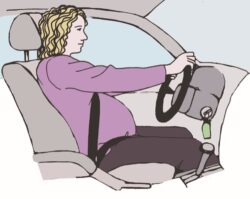At the Kidz in Motion conference, SRN was happy to learn about the Hudson Center for Prenatal Vehicle Safety (HCPVS), a nonprofit program of the UCHealth healthcare system based in Fort Collins, Colorado. HCPVS offers free materials to protect pregnant drivers, pregnant passengers, and unborn babies. Gregory Colton, the organization’s founder, staffed an exhibit booth and was also a presenter for a workshop titled “Seat Belt Use During Pregnancy: Improving Community Education.”
According to HCPVS, approximately 160,000 pregnant people are involved in traffic collisions every year. These crashes cause an estimated 92,500 maternal injuries, as well as 160 maternal and 1,293 fetal fatalities. In many cases, seat belt misuse and nonuse play a role in the outcome.
HCPVS’s mission is to end these tragedies through education about proper belt use. The center, named in honor of Dr. Margaret Hudson, a public health physician and philanthropist in the mid-20th century, has developed materials to teach the safest way for pregnant occupants to ride. Preventable injuries occur because many people don’t use a seat belt during pregnancy or wear one incorrectly, such as by allowing the lap belt to ride up over the belly or leaving a gap between the shoulder belt and the collarbone. Crash injuries can also occur when the body is positioned too close to the steering wheel.
Offering Free Resources
Free resources are available here. On the HCPVS homepage, click on the menu button (the three stacked lines) on the top left to access resources like an online guide for wearing a seat belt (with clarifying photos and video), an FAQ page, and tips for riding safely when using other forms of transportation while pregnant.
Other tools include free flyers and posters suitable for social media and in-person settings, like healthcare facilities, waiting rooms, restrooms, and safety fairs. One-page flyers are available in English and Spanish (or download the two-page bilingual version), as well as 14 other languages.
Rallying CPSTs to the Issue
As CPSTs work to prevent crash fatalities among infants from birth to age 1 (72 incidents per year in the U.S., on average), HCPVS notes that it is important to also address the issue of fetal fatalities in crashes, especially since these occur at a rate as much as 18 times greater.
HCPVS freely shares its program resources so that others can develop and/or improve educational programs for pregnant individuals in their own communities (see related article, below). An eight-page overview document titled Seat Belt Use During Pregnancy: Improving Community Education (also the title of Colton’s Kidz in Motion workshop) is essential reading for CPSTs.
HCPVS’s resources are backed by scientific research, with over 20 published studies on this topic cited on the website’s Research Articles page. Based on the research, the organization discourages the use of the various add-on belt adjuster products currently marketed for pregnant drivers and passengers; a tab on the menu provides the organization’s full rationale for this stance.
HCPVS’s Prenatal Belt Check Program Serves as Model
In addition to providing materials on its website (see above), HCPVS also applies its prenatal safety education through community outreach programs in Colorado.
HCPVS’s funder, UCHealth, has added prenatal belt checks to car seat checks and CPR training appointments for pregnant clients, reporting that each check takes only about 5 to 10 minutes. Although a prenatal belt check can be conducted during any stage of pregnancy, HCPVS says targeting it to occur early in the second trimester, when belt fit begins to be affected by body changes, is ideal.
Because most people buckle up absentmindedly, having this checkup to focus on belt use greatly improves the odds that a belt will be worn properly throughout pregnancy. As of press time, the HCPVS program had conducted 1,984 prenatal belt checks (and counting), with 1,126 requiring/receiving guidance for proper fit.
HCPVS’s Good-Better-Best Approach
When applying the good-better-best paradigm to educational approaches on this topic, HCPVS describes a good approach as sharing information through flyers (such as those provided on the website), while a better approach is in-person education (perhaps during a medical appointment or class). The best approach is to conduct a prenatal belt check where an educator assesses the pregnant person’s belt fit in the vehicle and provides corrective guidance as needed.
HCPVS has established these good-better-best methods using data, which shows clear incremental gains when employing better or best approaches. Follow-up data after prenatal belt checks shows that this interaction is very effective, promoting ongoing proper use nearly 92% of the time. Comparatively, among those who received no education or only written information, a seat belt was used properly only 15% and 29% of the time, respectively. Adding in-person education (better) doubled proper belt use to over 60% of the time, though that result falls far short of prenatal belt check (the best approach) effectiveness.
When its program is not implemented, HCPVS has found that nearly 80% of pregnant people receive either no education or simply written guidance. So, augmenting safety programs to include prenatal belt checks, or at least in-person guidance, would go a long way toward improving the safety of pregnant drivers, pregnant passengers, and unborn babies.
Those interested in learning more about prenatal belt checks and how to add them to their program can contact Colton at Gregory.Colton@UCHealth.org to get the technician guide, check form, and data reporting link.

